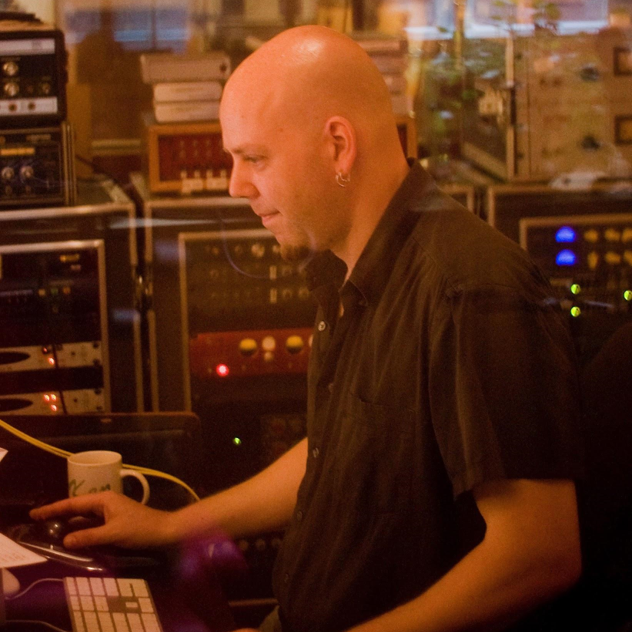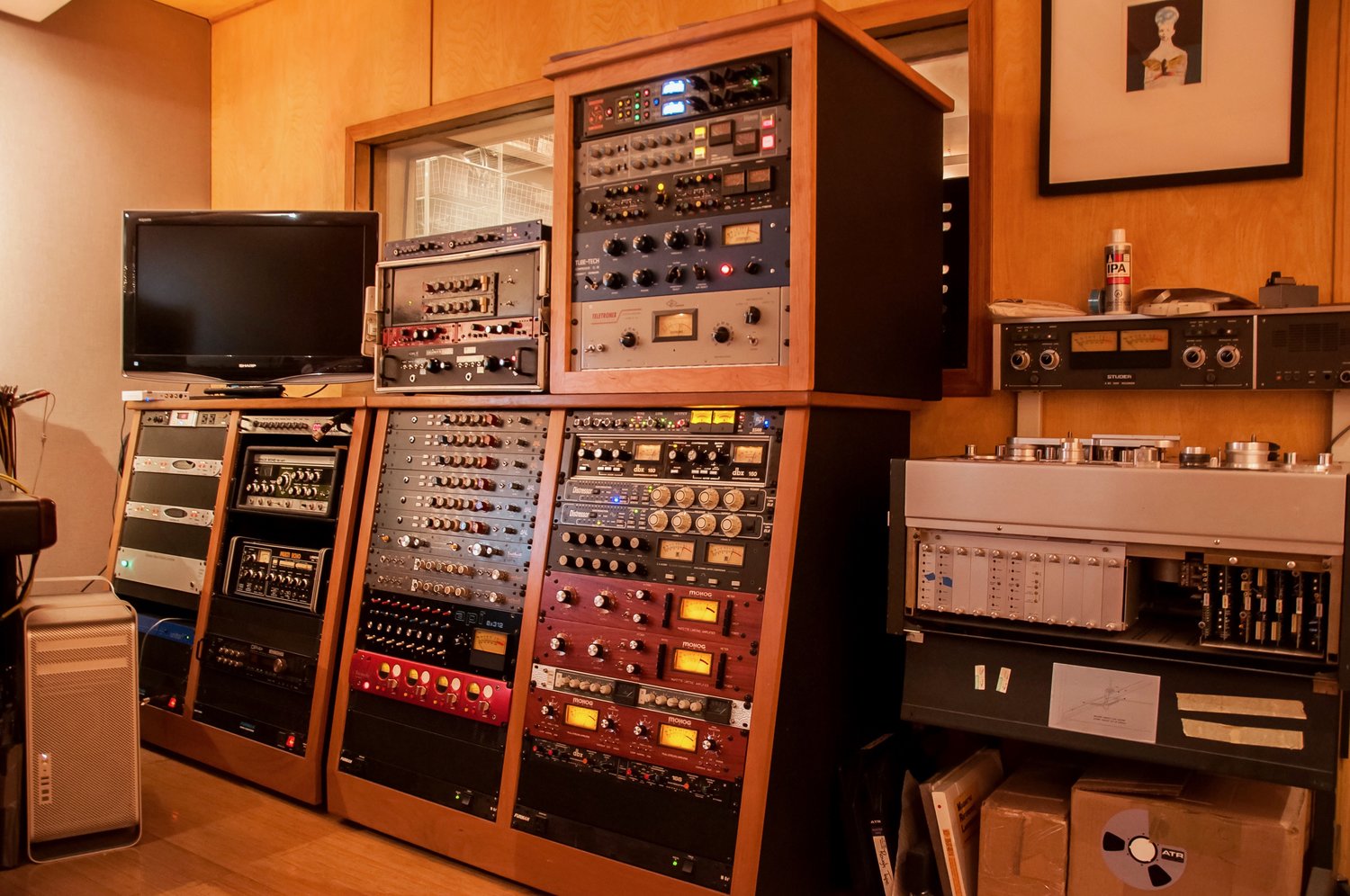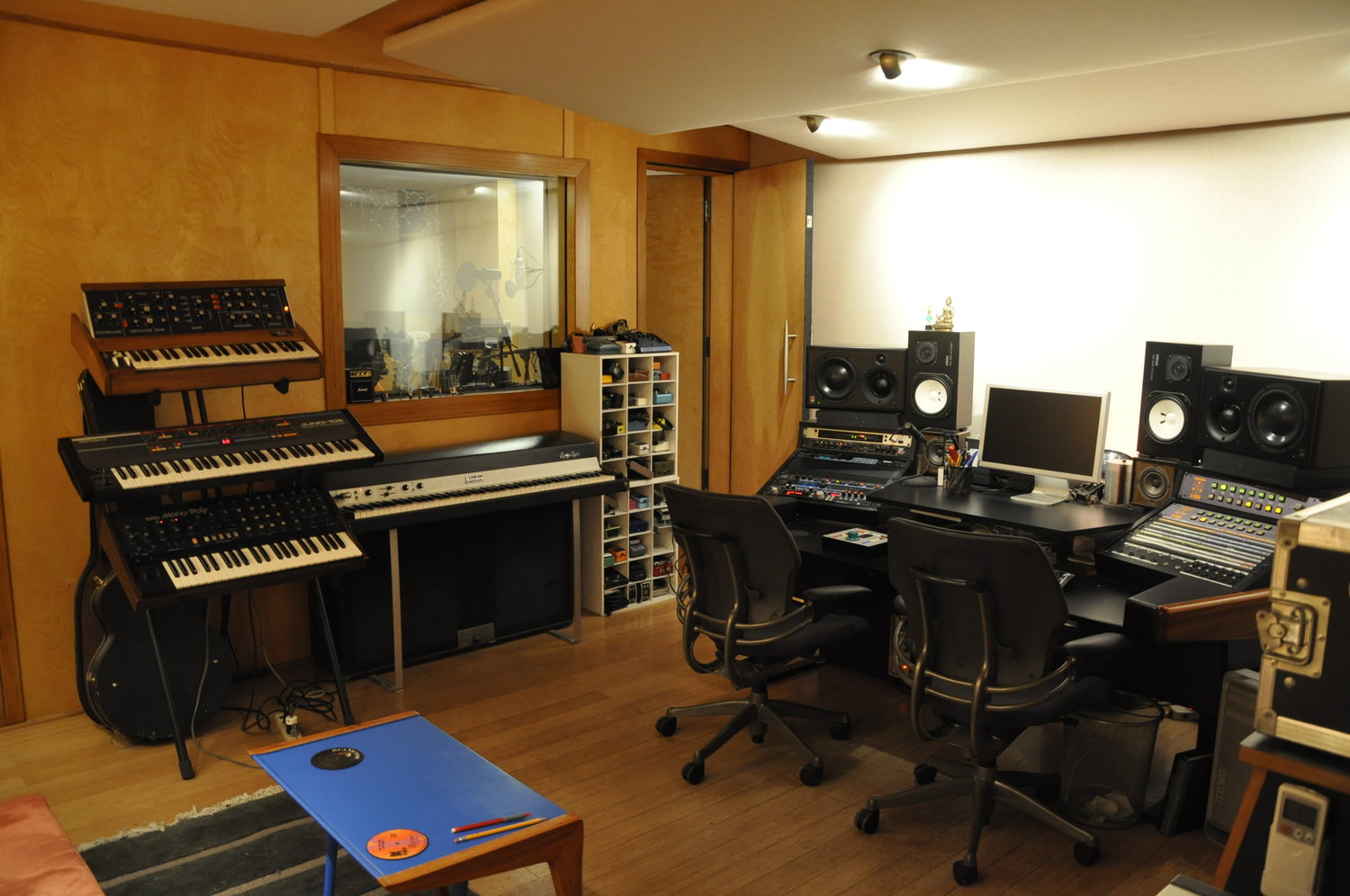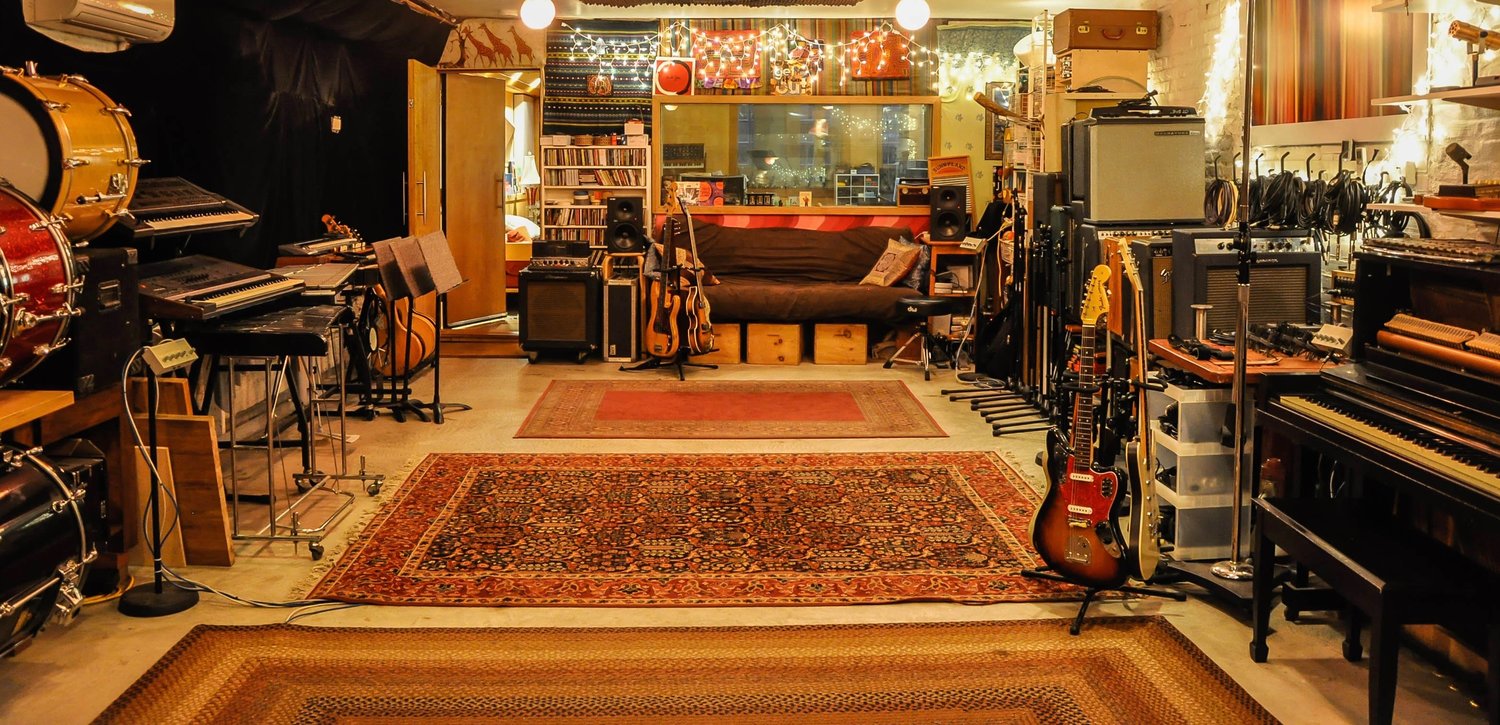The Studio Aesthetic: Ken Rich of Grand Street Recording (Part 2)
This is Part II of Will Kreth’s one-on-one interview with producer, engineer, composer, and musician Ken Rich, founder of Brooklyn’s Grand Street Recording. Don’t miss Part 1 of this in-depth Q&A right here.
It sounds like Grand Street is able to handle projects in any stage of completion.
Yes, projects come to us in a wide range of stages. In the case when someone has a new song, or even if it’s a work in progress I enjoy developing it into a fully-produced song. In those situations, I’ll often begin a project with an artist by just sitting in a room together and playing through the songs acoustically to establish song structure, key, tempo, feel. I’ve found that first intuitions in that simple context are often the best and most helpful in getting things right before we get bogged down with the more complex aspects of song production.
Are you still searching for that one golden artist – like the “Willy Wonka golden ticket”?
It never occurred to me to seek out an artist with the prospect of commercial accolades in mind. I’m really mostly focused on making good music. If an album does well it’s helpful insofar as it might generate more work, but it doesn’t necessarily make the music any better. I’m every bit as fulfilled by doing quality work with independent artists as I am working with more established artists.
Because if you’re looking for you won’t find it.,
Right. And if I made commercial success the goal of each project, I’d lose sight of what’s important. So, I focus on enjoying the process—what happens beyond that is really out of our control.
I get the feeling also, that while we talk about singer/songwriters, there’s really no one genre that predominates this place.
Yeah, we record a wide variety of music—last weekend we did an Indian classical recording which was very exciting and different, and we’ve worked with string quartets, rock, funk, gospel, pop, hip-hop, blues and jazz artists.
You mentioned once that sometimes you’ve inherited projects that were kind of abandoned at other studios. What’s that like, when you have to figure out what’s worth keeping from what’s already been done?
That’s a collaborative process with the artist; we start off by talking about the history of the recording sessions and what they’re happy with or unhappy with in those sessions. Then generally we’ll start small, maybe do a couple of songs, and then see if it’s worth salvaging what they’ve done before, or if it makes sense to start from scratch. We’ve also worked with a lot of people who have started a recording at home and then realize their limitations and want professional help.
What percentage of your work comes from referrals?
Oh, 90% easily. Our network has grown organically over time as we develop a history with artists, often from word of mouth referrals from musicians. I feel lucky to have so many great players that continue to recommend us.
30+ Snare Drums & Counting
Talk a little bit about that organic process of having a crew, acquiring vintage drums–you have 30+ snare drums alone–and acquiring gear.
As the studio began to grow into a professional facility, I ended up paying a lot of attention to curating a collection of gear and instruments which I felt contributed to great-sounding albums. Also, I’m fortunate to have good friends who have entrusted me with their instruments. Ethan Eubanks’ vast collection of snare drums lives at Grand Street; Rene Lopez loaned us his Leedy & Ludwig drum kit; and Andrew Sherman has his B3, Rhodes, Wurlitzer, Clavinet and synths in the studio as well. That really helped round out collection of gear I acquired over the years
This gets into the gearhead mindset here. How much of your equipment has had customization and been professionally worked on?
Most of it has required some level of care or customization. It’s been critical to have a really great tech. I’ve worked with John Charette for a long time, he wired the studio, built the patchbays and has maintained most of the vintage gear we have for the last 15 years. He has recapped all of our Neve, API, Calrec and Quad 8 pres and has done amazing work on our collection of guitar amplifiers by testing various tube and speaker configurations to help us find the best combination. Our tube compressors all have custom tube sets that we’ve auditioned or tried different op amps. Pedals get tweaked as needed and the guitars get regularly set up.
Microphone maintenance is a bit trickier, but I’m lucky to work with Clarence Kane for ribbon mic repair, who used to work at RCA. When they stopped making and repairing microphones, he acquired all of the gear and spare parts that they used as well as their original ribbon crimper machine. We use other techs to work on large diaphragm condenser mics, small diaphragm mics and dynamic mics. As a studio owner, you end up researching and pulling together a variety of specialists to work on all the different types of gear. It’s really a team effort to keep a studio like ours fully operational.
Tell me more about how Grand Street operates without a large format console.
All our preamps, compressors and effects are external. We have 32 channels of Class A mic pre-amps, and a full rack of compressors. We use the Cranesong Avocet as a controller and have two Dangerous 2 Busses to do all of the summing from 32 channels. So, in a way we’ve customized and built our own console, as far as functionality goes, without being necessarily encumbered by one particular manufacturer’s sound.
You know, if you record an entire album through an SSL, or Neve, while granted those are great sounds, you end up committing to a particular color for every instrument on the whole project. I feel that by having a variety of mic pres we’re able to better identify what sound we’re going for on each particular instrument.
Recently, when I’ve seen other engineers mix on a large format console, they generally have the all the channels normalized, and are doing their equalization and automation in Pro Tools. And that’s essentially the same scenario that we have in the Dangerous 2 Buss: a module that is normalized, mastering quality point-to-point wiring and sounds natural.
Where do you see the studio in five years? 10 years?
Well, I have a vision for another studio that I would like to build–not necessarily in Brooklyn but I would like to have a place that’s …
Equal to Woodstock??
(Laughs) Well, yeah! I mean, I have a vision for a place that records commercial clients, TV and film during the days, and then at nighttime could morph into a performance venue that would allow me to create audiophile recordings of live ensembles and independent artists with an audience.
I feel like there have been little nods this—there are venues that record live at night–but during the day, the venue just sits empty which is part of the reason I think so many great music spots have closed. Also, the recordings aren’t necessarily the same quality you’d get with studio grade equipment, and yet gear-wise, there’s potentially a lot of crossover between a music venue and a recording studio.
And is it the musician in you that sees the potential in this?
I suppose it’s the musician in me that appreciates the vitality of live performance. But also, I think it’s a forward-thinking vision. There are a lot of bands and artists who would like to share the recording process with their fans. And given how detached the music listening experience has become with infinite playlists and shuffle mode, I think it would be refreshing, at least from an audience’s perspective to share in the magic of a live recording.
A “Grand Street Sound”
I think it’s your personal story, your personal journey that you went through all these phases to get to this place where you’re at today–where you can somewhat control your own destiny– and that there could be hard times ahead or continued good times. But overall, you’ve got some part of your hand on the rudder. Would you say there’s “Grand Street Sound” that is emerging?
I do think so. You know, it just happens with any type of space where you make a lot of recordings with a specific collection of gear. There is an aesthetic that comes from the studio and production choices that are made in the recording process which contributes to a distinctive sound. Our goal is to create recordings that capture musicians’ energy in a specific time and place—I want the listener to feel like they’re in the room with us.
I’m still taken with the notion that you’ve got all this stuff set up in one place, concentrating your experience, gear and talent in one room.
We have a unique and cozy feel to our space and are fortunate to have many different types of musicians call it home. The wall between the live room and the control room is filled with a variety of tapestries collected by my grandparents during their world travels, which is often noticed by artists from other countries. “Oh, that’s an Africa batik”, or “that’s a Mola from Panama” or perhaps an Indian tapestry. It’s subtle, but it helps create a warm and inviting atmosphere.
It helps that our space is also filled wall to wall with instruments not always found in studios, such as a marxophone, a range of melodicas, a few accordions, a Mono-poly and even a Therimin just to name a few. Currently I’m enjoying experimenting with different techniques for recording with the vibrophone.
Part of my obsession with creating new sounds has lead me to an extensive curated collection of percussion instruments, some of which are kind of quirky, such as a Cochiti drum, a donkey jaw, finger cymbals, a limberjack and goat toes. Having a small and consistent staff also helps put people at ease. Clients always know what to expect and who they will be working with when they walk in the door.
It’s a great space. I hope you don’t move anytime soon or that the neighborhood somehow changes even more than already has.
Yeah, the changes have been scary fast–it’s just crazy. I mean, [in 2004] there was a truck lot behind us and then a gas station across the street, and now it’s largely luxury condos and rentals, but we’re sticking it out for now.
So, you said one of the things that distinguishes Grand Street is the quantity and quality of the guitars, amps, basses and keyboards at the studio.
Yes, in addition to all the odd-ball instruments we have a some pretty great instruments that I’ve collected over the past 30 years of creating music—sometimes I feel I’m a bit of a magnet for this stuff. We have some amazing vintage combo amps, half-stacks, modern combos, and about ten guitars to choose from. I have about a dozen basses that are all amazing instruments for different purposes. The same goes for the keys, drums, and synthesizers. There’s a wall of guitar and bass effect-pedals we use with almost anything. We re-amp things all the time and try all sorts of unorthodox combinations to create unique sounds. And we have 7 drum kits of various vintages, sizes and manufacturers—it’s a lot to maintain, but a labor of love to be sure.
What’s the oldest snare drum here?
That would be our 1920’s Piccolo Ludwig, but there are all sorts of special vintage pieces. In mics, I’ve got a few favorites: The Neumann U 47, U 67, U 87, KM 84s, KM 64s KM 56 and a Sony c37a, AKG C24, a pair of Gefell UM70S’s and also a more modern Lucas CS-4 microphone that is amazing.
I’m also a big fan of ribbon mics and have a RCA 44bx, RCA 77dx, Coles and an Altec Birdcage which I use whenever possible. I’m also a fan of the 60’s EV dynamic mics such as the RE15, RE16, 635a and 666.
What’s the oddest thing here?
(Laughs) Well, that really depends on your perspective. I think the coolest things is a turn-of-the-century acoustic guitar that was made by Montgomery Ward that used to belong to my Great Grandfather. You just never see those anymore. We have a harmonium and a couple old analog drum machines like the Ace Tone, Linn Drum and a Rhythm King. There’s also a didgeridoo and a sousaphone, which could be perceived as odd to find in a studio.
Some of the mics are really super oddball like the Turner 253 microphone which is amazing as a drum crunch mic and really shines on certain voices, but was never intended for music recording. Sometimes the more “character” sounds can help create something that’s really evocative in a song and can help give it a signature.
You have a custom-built 8 channel API preamp—tell us the story on that.
I’ve always loved the sound of the API 312 mic pres from the 70’s, particularly on electric guitar and percussive instruments, but could never afford or find space for one of their desks. So in lieu of a full console, I found eight vintage cards and located an API chassis from that era in Thailand.
I had it shipped to Brooklyn, and then created the faceplate design in CAD. John Charette wired everything together and its everything I hoped it would be. It was a bit of a pain, but the end result is that it sounds amazing and is built like a tank!
Any other custom customization tweaks / custom circuit benders?
I have a couple of Quad 8 mic pre’s that Ricky Begin built that are beautiful. For our Sony c37a Jake and I went through a series of three different tubes to just to identify which one was really best suited for that microphone. It was amazing how different they were. Eventually, we ended up with an old Phillips tube which really opened up the top end.
All of our tube compressors have undergone an audition process. A cool thing about the Mohog compressors is that they have switchable transformers: the Edcor transformer gives you a traditional 1176 sound, whereas the Carnhill transformer will give you a thicker, Neve-style sound. It becomes two distinct compressors in one unit.
You do a lot of A/B testing?
Tons, we’re always experimenting with new techniques and combinations of mic position, preamps, etc.. When we have a half day open Jake and I will put ten different microphones around a snare or piano. Stuff like that. It takes a lot of patience but it’s helpful in getting the engineers that work in the studio on the same page with techniques, and it helps us to develop a repertoire of sounds.
As a result, when we need to alter the sound while recording, we don’t necessarily just run for the EQ but rather look at mic placement and mic selection as the primary factor in coloring the sound.
In some ways you have the best of both worlds, pieces of a classic mixing console without a big-ass desk.
Right, and you know if something were to happen to your console, or if the power supply were to go out, your studio would be down for some time. In our case, if something goes on the fritz, we just pull that unit out and are able to still keep running.
In 14 years, we’ve never had a “dark day” here because of a technical issue (knock on wood!). With the computer we always have a clone drive on hand in case all of a sudden the main operating system flips out: Five minutes later we’re back up and working.
What’s the one thing that if you didn’t have, you’d miss it the most?
I’d really struggle without my 1960 P-Bass, which I use regularly, but beyond that, I have a pair of Neve 1272’s that were my first high-end audio purchase and are particularly juicy on bass. We also have AKG 10BX and BX20E1 spring reverbs—I’m very addicted to their sound. Every piece of gear that is here is special in a different way; all with different stories.
Producer, arranger, songwriter and lyricist Will Kreth is also the owner of MediaGroove Music (founded in 2006) and most recently was the executive director of EIDR.org. Previously at Showtime Networks, working on the data side of the film & TV industry, he co-founded Wired Magazine in 1992, after working for Apple. Former advisory board member to the Austin Music Foundation. Investor/Advisor to Critical Metrics (a music recommendation startup). With MediaGroove – produced, arranged, and launched 9 releases since 2010. Find him on LinkedIn at: https://www.linkedin.com/in/willkreth/.
Please note: When you buy products through links on this page, we may earn an affiliate commission.













[…] Yes, projects Read more… […]